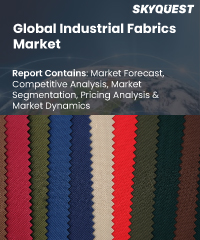
Report ID: SQMIG25M2040

Report ID:
SQMIG25M2040 |
Region:
Global |
Published Date: February, 2024
Pages:
157
|
Tables:
66 |
Figures:
75
The dominant region in the global industrial fabrics market based on region is Asia Pacific. Asia Pacific has emerged as a dominant market due to rapid industrialization, urbanization, and infrastructure development in countries like China and India. The region's large population, expanding manufacturing sector, and increasing investments in sectors such as automotive, construction, and agriculture drive the demand for industrial fabrics. Additionally, favorable government policies, low labor costs, and the presence of key manufacturers further contribute to Asia Pacific's dominance in the market.
The fastest-growing segment in the industrial fabrics market based on region is the Middle East and Africa (MEA). The MEA region is experiencing robust growth driven by significant infrastructure development, particularly in countries like the United Arab Emirates, Saudi Arabia, and Qatar. The construction industry in the region, along with investments in transportation, oil and gas, and mining sectors, fuels the demand for industrial fabrics. Furthermore, the increasing focus on industrial safety standards and the adoption of advanced materials in various applications contribute to the rapid growth of the industrial fabrics market in the Middle East and Africa.
Our industry expert will work with you to provide you with customized data in a short amount of time.
REQUEST FREE CUSTOMIZATIONWant to customize this report? This report can be personalized according to your needs. Our analysts and industry experts will work directly with you to understand your requirements and provide you with customized data in a short amount of time. We offer $1000 worth of FREE customization at the time of purchase.

Report ID: SQMIG25M2040